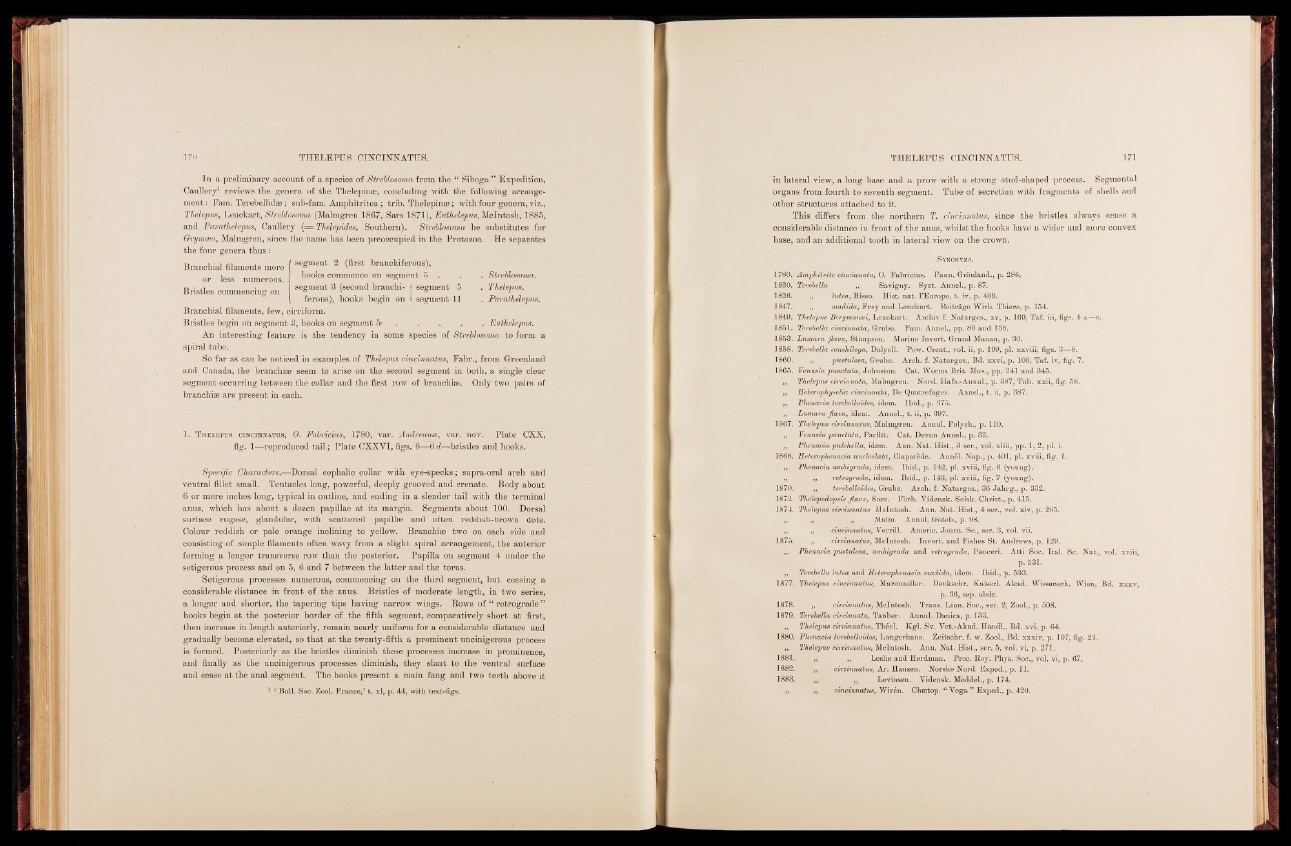
In a preliminary account of a species of Streblosoma from the “ Siboga r Expedition,
Caullery1 reviews the genera of the Thelepinse, concluding with the following arrangement
: Fam. Terebellidse ; sub-fam. Amphitritea; trib. Thelepinse; with four genera, viz.,
Thelepus, Leuckart, Streblosoma (Malmgren 1867, Sars 1871), Euthelepus, McIntosh, 1885,
and Parathelepus, Caullery (== Thelepid.es, Southern). Streblosoma he substitutes for
Grymaea, Malmgren, since the name has been preoccupied in the Protozoa. He separates
the four genera thus :
Branchial filaments more
or less numerous.
Bristles commencing on
segment 2 (first branchiferous),
hooks commence on segment 5 . . . Streblosoma.
segment 3 (second branchi- f segment 5 . Thelepus.
ferous), books begin on ( segment 11 . Parathelepus.
Branchial filaments, few, cirriform.
Bristles begin on segment 3, hooks on segment 5- . . . . Euthelepus.
An interesting feature is the tendency in some species of Streblosoma to form a
spiral tube.
So far as can be noticed in examples of Thelepus cincinnatus, Fabr., from Greenland
and Canada, the branchiae seem to arise on the second segment in both, a single clear
segment occurring between the collar and the first row of branchiae. Only two pairs of
branchiae are present in each.
1., T helepus orNCiNNATUS, 0. Fabricius, 1780, var. Andreanse, var. nov. Plate CXX,
fig. 1—reproduced tail; Plate CXXVI, figs. 6—6 d—bristles and hooks.
Specific Characters.—Dorsal cephalic collar with eye-specks; supra-oral arch and
ventral fillet small. Tentacles long, powerful, deeply grooved and crenate. Body about
6 or more inches long, typical in outline, and ending in a slender tail with the terminal
anus, which has about a dozen papillae at its margin. Segments about 100. Dorsal
surface rugose, glandular, with scattered papillae and often reddish-brown dots.
Colour reddish or pale orange inclining to yellow. Branchiae two on each side and
consisting of simple filaments often wavy from a slight spiral arrangement, the anterior
forming a longer transverse row than the posterior. Papilla on segment 4 under the
setigerous process and on 5, 6 and 7 between the latter and the torus.
Setigerous processes numerous, commencing on the third segment, but ceasing a
considerable distance in front of the anus. Bristles of moderate length, in two series,
a longer and shorter, the tapering tips having narrow wings. Rows of “ retrograde”
hooks begin at the posterior border of the fifth segment, comparatively short at first,
then increase in length anteriorly, remain nearly uniform for a considerable distance and
gradually become elevated, so that at the twenty-fifth a prominent uncinigerous process
is formed. Posteriorly as the bristles diminish these processes increase in prominence,
and finally as the uncinigerous processes diminish, they slant to the ventral surface
and cease at the anal segment. The hooks present a main fang and two teeth above it
1 ‘ Bull. Soc. Zool. France,’ t. xl, p. 44, with text-figs.
in lateral view, a long base and a prow with a strong stud-shaped process. Segmental
organs from fourth to seventh segment. Tube of secretion with fragments of shells and
other structures attached to it.
This differs from the northern T. cincinnatus, since the bristles always cease a
considerable distance in front of the anus, whilst the hooks have a wider and more convex
base, and an additional tooth in lateral view on the crown.
Synonyms.
1780. Amphitrite cincinnata, 0. Fabricius. Faun. Grönland., p. 286.
1820. Terebellà ,, Savigny. Syst. Annel., p. 87.
1826. ' lutea, Risso. Hist. nat. l’Europe, t. iv, p. 409.
1847. ,, madida, Frey and Leuckart. Beiträge Wirb. Thiere, p. 154.
1849. Thelepus Bergmanni, Leuckart. Archiv f. Naturges., xv, p. 169, Taf. iii, figs. 4 A—-c.
1851. Terebellà cincinnata, Grube. Fam. Annel., pp. 80 and 138.
1853. Lumara flava, Stimpson. Marine Invert. Grand Manan, p. 30.
1858. Terebellà conchilega, Dalyell. Pow. Créât., vol. ii, p. 199, pi. xxviii, figs. 3—8.
I860. „ pustulosa, Grube. Arch, f. Naturges., Bd. xxvi, p. 100, Taf. iv, fig. 7.
1865. Venusia pimctata, Johnston. Cat. Worms Brit. Mus., pp. 241 and 345.
„ Thelepus circinnata, Malmgren. Nord. Hafs.-Annul., p. 387, Tab. xxii, fig. 58.
„ Heterophyselia cincinnata, De Quatrefages. Annel., t. ii, p. 387.
Phenacia terebelloides, idem. Ibid., p. 375.
,, „> . Lumara flava, idem. Annel., t. ii, p. 397.
1867. Thelepus circinnatus, Malmgren. Annul. Polych., p. 110.
„ Venusia punctata, Parfitt. Cat. Devon Annel., p. 32.
’« „ Phenacia pulchella, idem. Ann. Nat. Hist., 3 ser., vol. xliii, pp. 1, 2, pi. i.
1868. Heterophenacia nucleolata, Claparède. Annel. Nap., p. 401, pi. xviii, fig. 1.
' ■ „ Phenacia ambigrada, idem. Ibid., p. 142, pi. xviii, fig. 6 (young).
„ ,, rétrograda, idem. Ibid., p. 143, pi. xviii, fig. 7 (young).
1870. ,, te)‘ebelloides, Grube. Arch. f. Naturges., 36 Jahrg., p. 332.
1872. Thelepodopsis flava, Sars. Förh. Vidensk. Selsk. Christ., p. 415.
1874. Thelepus circinnatus McIntosh. Ann. Nat. Hist., 4 ser., vol. xiv, p. 205.
„ ,, Malm. Annul. Göteb., p. 98-
„ „ cincinnatus, Verrill. Americ. Journ. Sc., ser. 3, vol. vii.
1875. „ circi/rmatus, McIntosh. Invert, and Fishes St. Andrews, p. 129.
„ Phenacia pustulosa, ambigrada and rétrograda, Panceri. Atti Soc. Ital. Sc. Nat., vol. xviii,
p. 531.
,, Terebellà lutea and Heterophenacia madida, idem. Ibid., p. 530.
1877. Thelepus cincinnatus, Marenzeller. Denkschr. Kaiserl. Akad. Wissensch. Wien, Bd. xxxv,
p. 36, sep. abdr.
1878. ,, circinnatus, McIntosh. Trans. Linn. Soc., ser. 2, Zool., p. 508.
1879. Terebellà circinnata, Tauber. Annul. Danica, p. 133.
„ Thelepus circinnatus, Théel. Kgl. Sv. Vet.-Akad. Handl., Bd. xvi, p. 64.
1880. Phenacia terebelloides, Langerhans. Zeitschr. f. w. Zool., Bd. xxxiv, p. 107, fig. 21.
„ Thelepus circinnatus, McIntosh. Ann. Nat. Hist., ser. 5, vol. vi, p. 271.
1881. „ „ Leslie and Herdman. Proc. Roy. Phys. Soc., vol. vi, p. 67.
1882. „ circinnatus, Ar. Hansen. Norske Nord. Exped., p'. 11.
1883. „ „ Levinsen. Yidensk. Meddel., p. 174.
„ ,, cincinnatus, Wirén. Chætop. “Vega” Exped., p. 420.